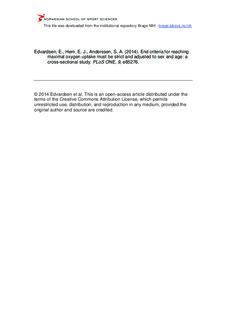| dc.contributor.author | Edvardsen, Elisabeth | |
| dc.contributor.author | Hem, Erlend Jan | |
| dc.contributor.author | Anderssen, Sigmund A. | |
| dc.date.accessioned | 2014-11-13T14:08:32Z | |
| dc.date.available | 2014-11-13T14:08:32Z | |
| dc.date.issued | 2014-01-14 | |
| dc.identifier.citation | PLoS ONE. 2014, 9, e85276 | nb_NO |
| dc.identifier.uri | http://hdl.handle.net/11250/225880 | |
| dc.description | © 2014 Edvardsen et al. This is an open-access article distributed under the terms of the Creative Commons Attribution License, which permits unrestricted use, distribution, and reproduction in any medium, provided the original author and source are credited. | nb_NO |
| dc.description.abstract | Objective: To describe different end criteria for reaching maximal oxygen uptake (VO2max) during a continuous graded exercise test on the treadmill, and to explore the manner by which different end criteria have an impact on the magnitude of the VO2max result. Methods: A sample of 861 individuals (390 women) aged 20–85 years performed an exercise test on a treadmill until exhaustion. Gas exchange, heart rate, blood lactate concentration and Borg Scale6–20 rating were measured, and the impact of different end criteria on VO2max was studied;VO2 leveling off, maximal heart rate (HRmax), different levels of respiratory exchange ratio (RER), and postexercise blood lactate concentration. Results: Eight hundred and four healthy participants (93%) fulfilled the exercise test until voluntary exhaustion. There were no sex-related differences in HRmax, RER, or Borg Scale rating, whereas blood lactate concentration was 18% lower in women (P<0.001). Forty-two percent of the participants achieved a plateau in VO2; these individuals had 5% higher ventilation (P = 0.033), 4% higher RER (P<0.001), and 5% higher blood lactate concentration (P = 0.047) compared with participants who did not reach a VO2 plateau. When using RER ≥1.15 or blood lactate concentration ≥8.0 mmol•L–1, VO2max was 4% (P = 0.012) and 10% greater (P<0.001), respectively. A blood lactate concentration ≥8.0 mmol•L–1 excluded 63% of the participants in the 50–85-year-old cohort. Conclusions: A range of typical end criteria are presented in a random sample of subjects aged 20–85 years. The choice of end criteria will have an impact on the number of the participants as well as the VO2max outcome. Suggestions for new recommendations are given. | nb_NO |
| dc.language.iso | eng | nb_NO |
| dc.publisher | PLOS | nb_NO |
| dc.subject | age groups | nb_NO |
| dc.subject | blood | nb_NO |
| dc.subject | elderly | nb_NO |
| dc.subject | exercise | nb_NO |
| dc.subject | oxygen | nb_NO |
| dc.subject | respiration | nb_NO |
| dc.subject | sports and exercise medicine | nb_NO |
| dc.subject | technicians | nb_NO |
| dc.title | End criteria for reaching maximal oxygen uptake must be strict and adjusted to sex and age: a cross-sectional study | nb_NO |
| dc.type | Journal article | nb_NO |
| dc.type | Peer reviewed | nb_NO |
| dc.subject.nsi | VDP::Mathematics and natural science: 400::Basic biosciences: 470 | nb_NO |
| dc.subject.nsi | VDP::Agriculture and fishery disciplines: 900::Agriculture disciplines: 910 | nb_NO |
| dc.source.journal | PLoS ONE | nb_NO |
| dc.description.localcode | Seksjon for idrettsmedisinske fag / Department of Sports Medicine | nb_NO |
